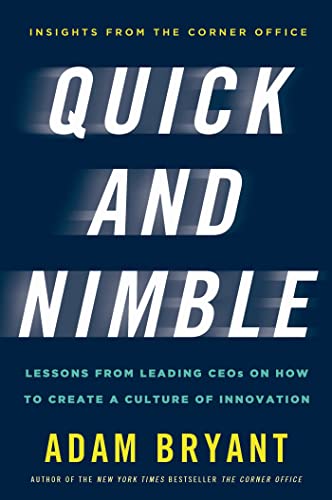Items related to Quick and Nimble: Lessons from Leading CEOs on How...
Quick and Nimble: Lessons from Leading CEOs on How to Create a Culture of Innovation - Insights from The Corner Office - Hardcover

Synopsis
More than two hundred CEOs reveal their candid insights on how to build and foster a corporate culture that encourages innovation and drives results
In Quick and Nimble, Adam Bryant draws on interviews with more than two hundred CEOs to offer business leaders the wisdom and guidance to move an organization faster, to be quick and nimble, and to rekindle the whatever-it-takes collective spark of a start-up workplace, all with the goal of innovating and thriving in a relentlessly challenging global economy. By analyzing the lessons that these leaders have shared in his regular "Corner Office" feature in The New York Times, Bryant has identified the biggest drivers of corporate culture, bringing them to life with real-world examples that reflect this hard-earned wisdom.
These men and women―whose ranks include Jeff Weiner of LinkedIn, Tony Hsieh of Zappos, Angie Hicks of Angie's List, Steve Case of Revolution (and formerly AOL), and Amy Gutmann of the University of Pennsylvania―offer useful insights and strategies for creating a corporate culture of innovation and building a high-performing organization that unleashes the passion and energy of its employees.
As the world shifts to more of a knowledge economy, the winners will be companies that can attract and retain the best and brightest employees by creating an environment where they can grow, contribute, and feel rewarded. Through the wisdom of these leading chief executives, Quick and Nimble offers a keen understanding of leadership, recruiting, and the forces that shape corporate culture and a clear road map to bring success and energy to any organization.
"synopsis" may belong to another edition of this title.
About the Author
Adam Bryant is the author of the New York Times bestseller The Corner Office: Indispensable and Unexpected Lessons from CEOs on How to Lead and Succeed. He writes the popular "Corner Office" feature in The New York Times's business section and has served as the newspaper's senior editor for features, deputy national editor, and deputy business editor. He was previously a senior writer and business editor at Newsweek. He and his family live in New York City.
"About this title" may belong to another edition of this title.
FREE shipping within U.S.A.
Destination, rates & speedsSearch results for Quick and Nimble: Lessons from Leading CEOs on How...
Quick and Nimble: Lessons from Leading CEOs on How to Create a Culture of Innovation - Insights from The Corner Office
Seller: SecondSale, Montgomery, IL, U.S.A.
Condition: Good. Item in very good condition! Textbooks may not include supplemental items i.e. CDs, access codes etc. Seller Inventory # 00075693886
Quantity: 3 available
Quick and Nimble: Lessons from Leading CEOs on How to Create a Culture of Innovation - Insights from The Corner Office
Seller: SecondSale, Montgomery, IL, U.S.A.
Condition: Very Good. Item in very good condition! Textbooks may not include supplemental items i.e. CDs, access codes etc. Seller Inventory # 00078146566
Quantity: 1 available
Quick and Nimble: Lessons from Leading CEOs on How to Create a Culture of Innovation - Insights from The Corner Office
Seller: Jenson Books Inc, Logan, UT, U.S.A.
hardcover. Condition: Good. The item is in good condition and works perfectly, however it is showing some signs of previous ownership which could include: small tears, scuffing, notes, highlighting, gift inscriptions, and library markings. Seller Inventory # 4BQWN80049U8
Quantity: 1 available
Quick and Nimble: Lessons from Leading CEOs on How to Create a Culture of Innovation - Insights from The Corner Office
Seller: Your Online Bookstore, Houston, TX, U.S.A.
Hardcover. Condition: Good. Seller Inventory # 0805097015-3-22320394
Quantity: 1 available
Quick and Nimble: Lessons from Leading CEOs on How to Create a Culture of Innovation - Insights from The Corner Office
Seller: Gulf Coast Books, Cypress, TX, U.S.A.
Hardcover. Condition: Good. Seller Inventory # 0805097015-3-18054750
Quantity: 1 available
Quick and Nimble: Lessons from Leading CEOs on How to Create a Culture of Innovation - Insights from The Corner Office
Seller: Wonder Book, Frederick, MD, U.S.A.
Condition: Very Good. Very Good condition. Very Good dust jacket. A copy that may have a few cosmetic defects. May also contain light spine creasing or a few markings such as an owner's name, short gifter's inscription or light stamp. Seller Inventory # V08N-00329
Quantity: 1 available
Quick and Nimble: Lessons from Leading CEOs on How to Create a Culture of Innovation - Insights from The Corner Office
Seller: Wonder Book, Frederick, MD, U.S.A.
Condition: As New. Like New condition. Very Good dust jacket. A near perfect copy that may have very minor cosmetic defects. Seller Inventory # Q11M-00240
Quantity: 1 available
Quick and Nimble : Lessons from Leading CEOs on How to Create a Culture of Innovation
Seller: Better World Books, Mishawaka, IN, U.S.A.
Condition: Good. Former library book; may include library markings. Used book that is in clean, average condition without any missing pages. Seller Inventory # 4475946-6
Quantity: 1 available
Quick and Nimble : Lessons from Leading CEOs on How to Create a Culture of Innovation
Seller: Better World Books, Mishawaka, IN, U.S.A.
Condition: Good. Used book that is in clean, average condition without any missing pages. Seller Inventory # 5467245-6
Quantity: 1 available
Quick and Nimble : Lessons from Leading CEOs on How to Create a Culture of Innovation
Seller: Better World Books, Mishawaka, IN, U.S.A.
Condition: Very Good. Former library book; may include library markings. Used book that is in excellent condition. May show signs of wear or have minor defects. Seller Inventory # GRP102231203
Quantity: 1 available

